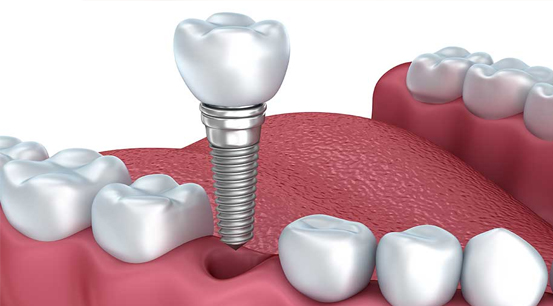Prosthetic Dentistry is primarily concerned with replacing the teeth we have lost.
click on the service that you are interested in
Frequently a tooth is planned to be restored with a dental filling, but the decay or fracture is so extensive that a direct restoration, such as amalgam or composite, would compromise the structural integrity of the restored tooth or provide substandard opposition to occlusal (i.e., biting) forces. In such situations, an indirect gold, lab composite or porcelain inlay restoration may be indicated.
When severe damage to the cusps of the tooth has occurred, an onlay might be indicated.
 Similar to an inlay, an onlay is an indirect restoration which incorporates a cusp or cusps by covering or onlaying the missing cusps. All of the benefits of an inlay are present in the onlay restoration.
Similar to an inlay, an onlay is an indirect restoration which incorporates a cusp or cusps by covering or onlaying the missing cusps. All of the benefits of an inlay are present in the onlay restoration.
The onlay allows for conservation of tooth structure when the only alternative is to totally eliminate cusps and perimeter walls for restoration with a crown.
Just as inlays, onlays are fabricated in the lab and are typically made out of gold, lab composite or porcelain.
A crown is used to cover a tooth and may be commonly referred to as a "cap."
Traditionally, the teeth to be crowned are prepared by a dentist, and records are given to a dental technician to construct the prosthesis. The records include models, which are replicas of a patient's teeth, and the impressions used to make these models.
There are many different methods of crown fabrication, each using a different material. Some methods are quite similar, and utilize either very similar or identical materials. Crowns may be made of gold or other similar metals, porcelain (all-ceramic crowns), or a combination of the two (metal-ceramic crowns).

A bridge is used to span, or bridge, an edentulous area (space where teeth are missing).
Teeth adjacent to the gap are prepared by the dentist and records are given to the dental lab to construct the prosthesis.
The teeth used to support the bridge are called abutments. The part of the bridge which replaces a missing tooth and attaches to the abutments is known as a "pontic."
For multiple missing teeth, some cases may have several pontics.
Dentures are prosthetic devices constructed to replace missing teeth, and are supported by surrounding soft and hard tissues of the oral cavity.
Conventional dentures are removable, however there are many different denture designs, some which rely on bonding or clasping onto teeth or dental implants.
The latter are called implant overdentures (dentures on implants).
There are two main categories of dentures, depending on whether they are used to replace some or all the missing teeth on the mandibular or the maxillary arch.
Removable partial dentures are for patients who are missing some of their teeth on a particular arch whereas complete dentures or full dentures are worn by patients who are missing all of the teeth in a single arch (i.e. the maxillary (upper) or mandibular (lower) arch).
Modern dentures are fabricated in a commercial dental laboratory using a combination of a tissue shaded powder polymethylmethacrylate acrylic for the tissue shaded aspect, and commercially produced acrylic teeth available in hundreds of shapes and tooth colors.
Once fitted and adjusted to, the denture will increase patient’ masticatory ability,speech,facial aesthetics and overall improve on patient's self-esteem.
Maxillofacial prosthetics is a branch of dentistry that deals with congenital and acquired defects of the head and neck.
Maxillofacial prosthetics integrates parts of multiple disciplines including head and neck oncology, congenital malformation, plastic surgery, speech, and other related disciplines.

Patients diagnosed with oral cancer will undergo careful preoparative planning that includes establishing a good oral hygiene level, restoration of decayed teeth and root scaling. When the lesion is located in the upper jaw mandating a partial or full maxillectomy, a presurgical (immediate) obturator is fabricated for placement during surgery. Upon completion of the supplementary treatment (chemotherapy, radiotherapy) the surgical obturator is replaced by an intermediate obturator, allowing for better speech, mastication and aesthetics.
When the lesion is located in the lower jaw, a radical alveolectomy with preservation of mandibular continuity or a lateral resection of the mandible followed by titanium plate and bone graft restoration is usually the treatment of choice.
Mastication and aesthetics are then restored using dental implants and fixed or removable prostheses.
Book your appointment
SERVICES
Comprehensive dental care using the most up-to-date devices and personalized treatment plans for the needs of each patient.









